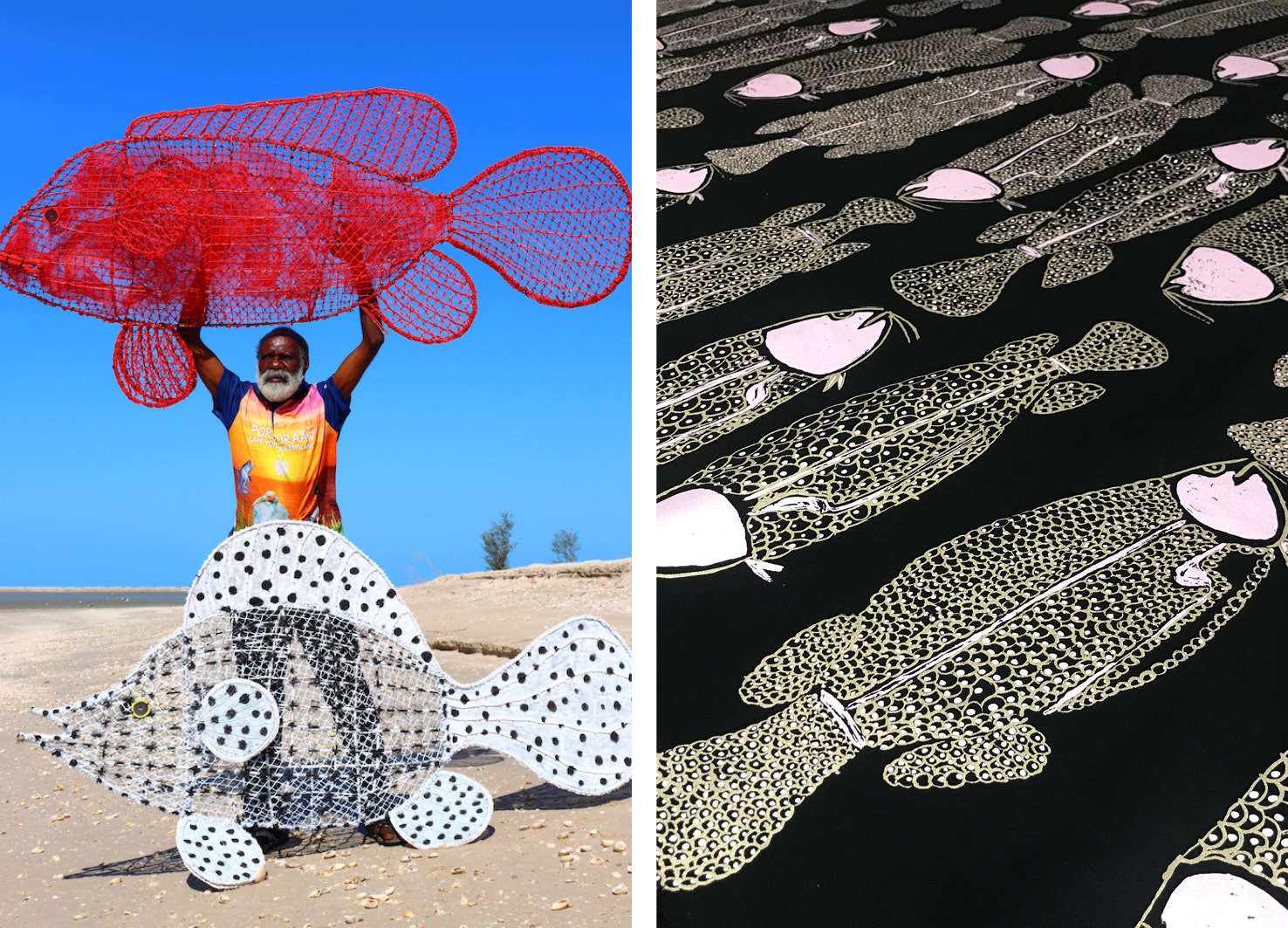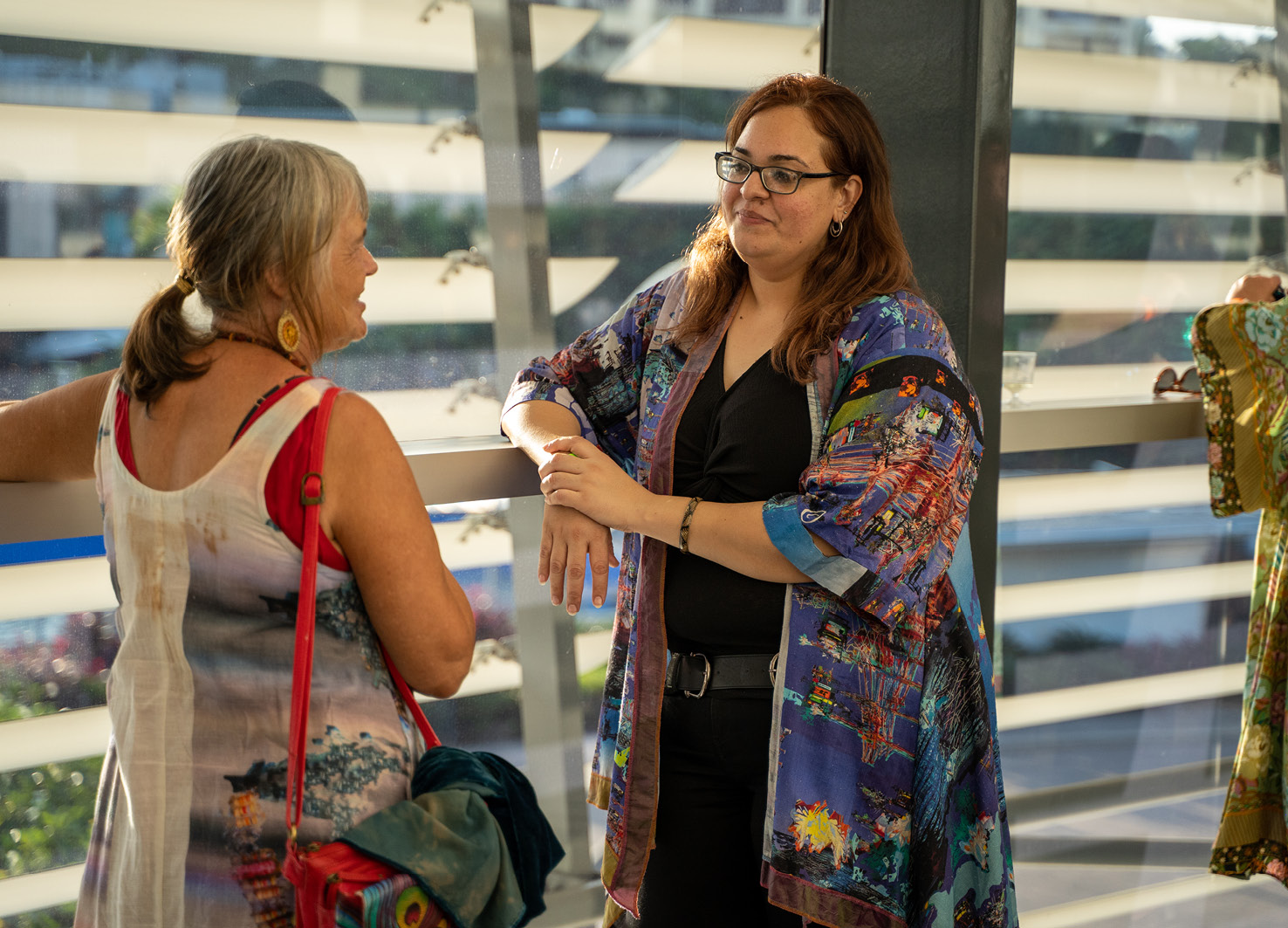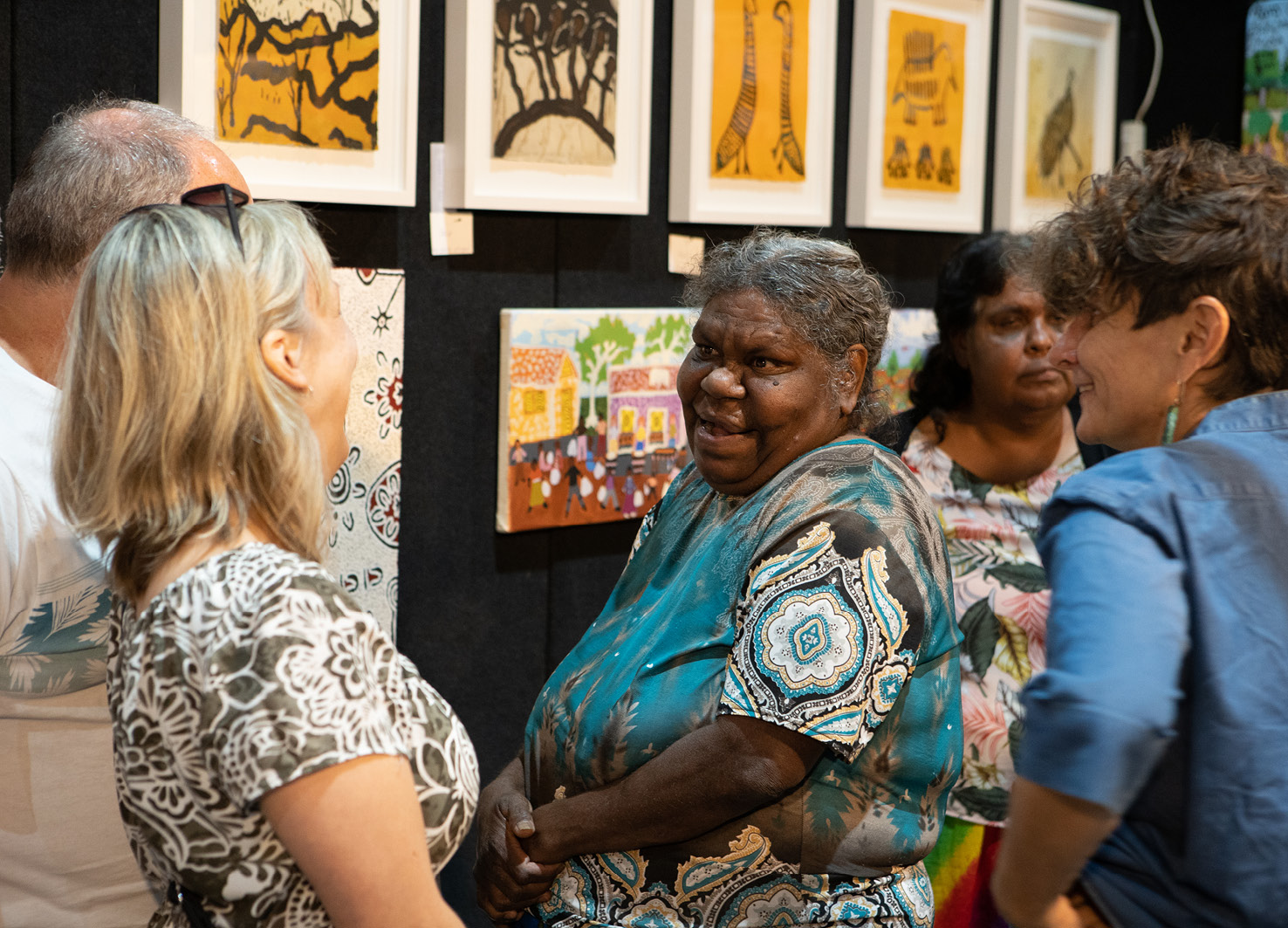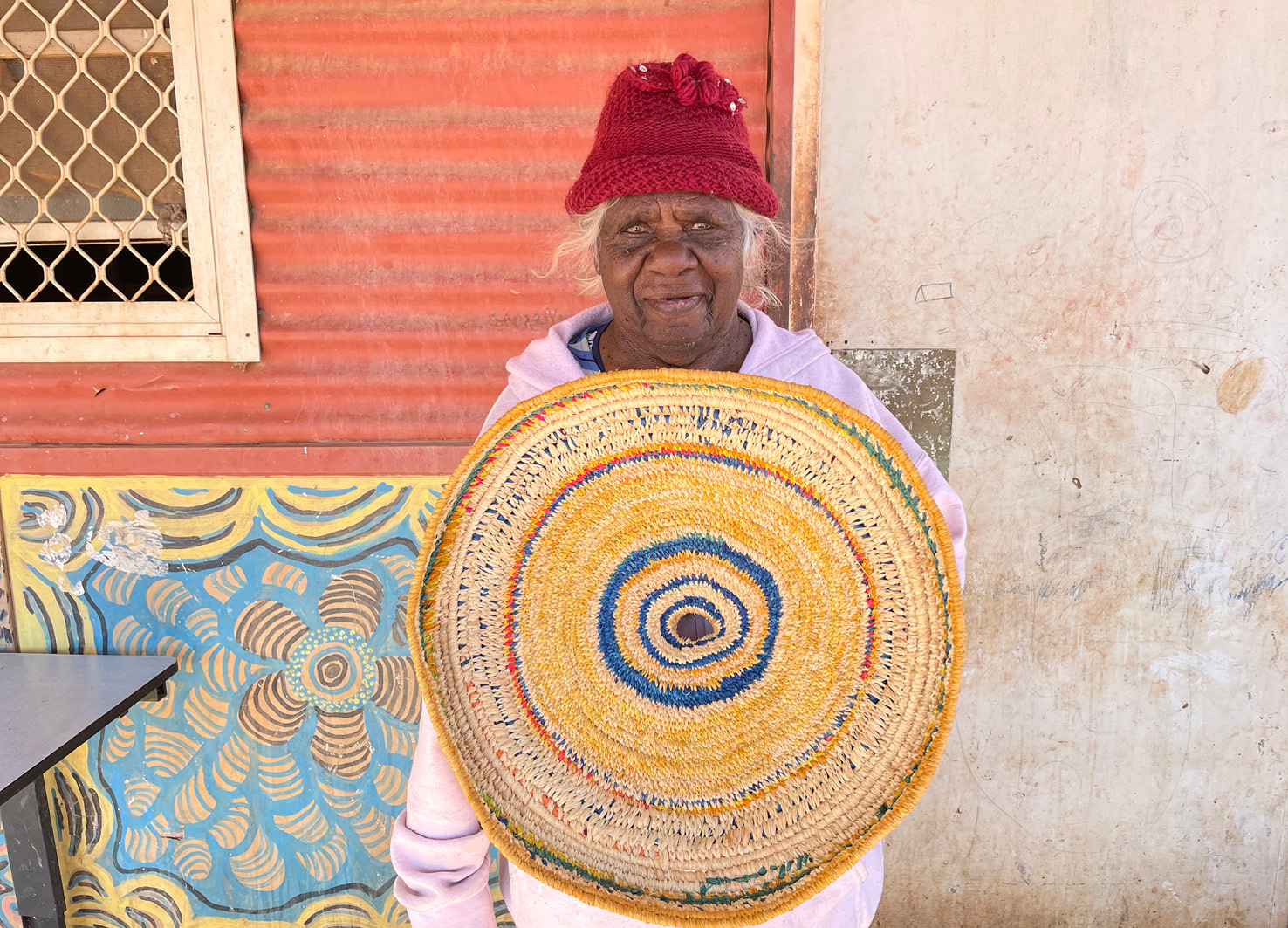
“Vibrant, Thriving, Living Cultures”: DAAF’s Artistic Director on the Power and Place of Art Festivals
The Darwin Aboriginal Art Fair (DAAF) is back for 2022! Held on Larrakia Country in the heart of the Northern Territory’s enigmatic capital city from 5–7 August at the Darwin Convention Centre, the annual art fair, which Peppermint is once again proud to partner with, is a cultural celebration unlike any other in Australia. Showcasing the exceptional Indigenous creatives on our shores – and encompassing the National Indigenous Fashion Awards (3 August) and Country to Couture fashion showcase (2 August) – its mission is to represent First Nations designers, artists and creatives while promoting Indigenous culture and community more broadly.
In the lead-up to this year’s fair, we chat with Artistic Director Shilo McNamee, who shares her highlights and insider tips for DAAF 2022’s vibrant program of cultural performances, artist workshops and demonstrations, Indigenous food experiences, industry talks and its corresponding online program.
Why does DAAF continue to hold such a respected and important place on the national events calendar after 15 years?
Despite our many achievements as an organisation, we don’t have a big ego. We pride ourselves on a strong ethical standpoint, making sure our art centres come first. I think people appreciate that we’re a dynamic organisation that’s constantly adapting to the needs of our members and audiences – we are never going to try to fit a square peg in a round hole!

left SYD BRUCE SHORTJOE WITH HIS GHOST NET AND RECYCLED MATERIALS SCULPTURES. PHOTO BY PAUL JAKUBOWSKI COURTESY of PORMPURAAW ART & CULTURE CENTRE; right CAROL LIYAWANGA ARTWORK PHOTO COURTESY OF BABARRA WOMEN’S CENTRE.
Why does it continue to be so important to celebrate and share First Nations and BIPOC cultures through this kind of festival?
Events such as these are an important tool that not only give context to the past but show the continuation of culture. These artworks and displays are there to be appreciated, not as static museum pieces but as vibrant, thriving, LIVING cultures.
How can allies continue to support outside of attending festivals?
It’s important to stay engaged and continue growing their knowledge and awareness of our cultural landscape. It may seem immense to begin with but just start with getting to know one art centre and its story. Keep following the thread, get to know the people behind it, the managers, the artists and arts workers and expand from there.
What’s the history of the DAAF Foundation and how has the festival contributed to the growth of the Aboriginal art scene?
The inaugural Darwin Aboriginal Art Fair event was held in 2007, hosting 16 Aboriginal-owned incorporated art centres. The event was originally founded by Apolline Kohen, former director of Maningrida Art and Culture (MAC). MAC’s then assistant director, Claire Summers, managed the event.
The art fair has grown with each passing year, extending its reach further afield to a point where we’re even reaching and growing international audiences! We stay in conversation with our art centres throughout the year and make sure that they’re at the forefront of everything we do. It’s important for us to support artists and their art centres to be able to share their art and culture in ways that suit them. Simply put, our role at DAAFF is to create promotional platforms and opportunities for the art centres we represent.

image SHILO MCNAMEE 2021, PHOTO BY DYLAN BUCKEE.
Tell us a bit about yourself and how you became involved with DAAF?
I have a strong connection to Darwin; I was born and raised here. I have great memories of my school years. My friends and I started our journey into the Darwin arts community by getting to know our teachers and actually seeing how they practised and balanced life as creatives in Darwin’s thriving arts community. It made a career in the arts feel very real and attainable. I also grew up as a part of a very creative family – my siblings and parents are all artists or musicians (or both)!
After completing Year 12, I was at a point where I needed to decide if I wanted to study visual arts or music at a tertiary level – I decided on visual arts – and in 2008 received my bachelor’s degree from Charles Darwin University.
By 2018, I’d done a little exploration into the world of arts admin and management after working as the Darwin Visual Arts associate manager. I came on board with a short-term contract to coordinate the DAAF Public Program. The organisation and I seemed a good fit for each other, so I was invited to stay and join the team on a more permanent basis. My role has been expanding with each passing year, leading to my current appointment.
What does an average day as the artistic director of DAAF look like?
Day to day my role is quite varied, from developing ideas for new programs and modes of delivery, to delivering workshops and sketching out elements for creative concepts. My role requires that I stay connected to our stakeholders and keep various conversations rolling throughout the year. Our art centres, managers and curators are all incredibly busy with different projects. I need to be in the know about what they’re up to and how we can support and promote them, whether it’s part of our public programs or something different entirely.
In addition to the DAAF Public and Cultural Keepers programs, there’s also a fair bit of creative design in my role thanks to the creative direction of the various Indigenous Fashion Projects runways and events.

image TANGWNRYERE ARTISTS AND YARRENYTY ARLTERE ARTISTS AT 2019 DARWIN ABORIGINAL ART FAIR PHOTO BY DYLAN BUCKEE.
The work you do to represent your 70+ member art centres continues well beyond the festival dates. Can you explain a little bit about what DAAFF does to support artists and the community throughout the year?
We’re always available to our art centre members, and we make sure that we’re ready to respond and adapt to their needs. A great example is the digital pivot that took place in 2020. Our first task was to call each and every one of our members to find out how they were going and if they were ok – and then to workshop how we could best support them. It was from there that our digital platform was born!
What’s your favourite part of the job?
I love working with other creatives and sharing my skills. I especially enjoy the workshop and masterclass series we offer. They allow me to work closely with artists and tap into my background as an artist. My skill set allows me to be able to help plan, organise materials and the structure of workshops and troubleshoot any potential issues so that artists feel capable and confident in teaching participants.

image BETTY MUFFLER WITH HER BASKET, 2021. PHOTO BY EMMA FRANKLIN, COURTESY OF TJANPI DESERT WEAVERS.
What are the highlights of this year’s public program that you’re particularly excited about?
I’m really excited to be able to see everyone again and experience the energy of a live event – and the artist demonstrations are something I’m [particularly] excited about. Our event is about celebrating art and culture, so I love that audiences will be able to see artists working and creating onsite much like an open studio. I think it will bring a great atmosphere!
Can you share a bit about the process of pulling together the Public Program? How do you select artists and what are the themes that you’re trying to convey?
We have an application process that is usually open from November to April. Art centres can apply to a number of different elements. I love that our program is dynamic and ever-changing. We’re always looking to create opportunities for indigenous people to share culture in ways that appeal to them. We look over all the proposals quite closely to make sure our program structure supports and promotes the artists in the best way possible.
image JOY NGINANA LYONS OUT ON COUNTRY WITH HER ARTWORK ‘KUNGKARRANGKALPA’ (SEVEN SISTERS). PHOTO BY ATHENA HOOK, COURTESY OF PAPULANKUTJA ARTISTS ABORIGINAL CORPORATION.
What should someone coming to the festival for the first time definitely check out?
Each year we produce a wonderful art centre map that lives at the front of the fair, it shows where all of our stallholders have come from. I recommend taking the time to get to know and memorise some of the participating art centres. Each art centre stall offers visitors a unique little window into a different world and different parts of our country.
Although DAAF has been running since 2007, the last few years has seen it take its place on the national stage. Why do you think that is?
The past few years saw a number of challenges thrown our way, but I think, to our credit, the DAAF team are all highly adaptable and incredibly passionate about the work we do and we all strive to do our best – we’re a small but dedicated team!
While we’ve been pretty brave and ambitious with our undertakings, our extensive consultation with our members at each new step means that we operate from a position of confidence. We have been able to reach new heights because we always operate from a position of openness and transparency – and I think our stakeholders and audiences can see and appreciate that.

image COURTESY OF COUNTRY TO COUTURE.
Why do you think Country to Couture and the NIFAs have become such attractions?
It’s wonderful to see how much the local audience in particular has embraced these events. I think, for Country to Couture in particular, there’s a wonderful grassroots energy, while also maintaining the flow of a professional and well-executed event. We try to make sure that people feel they can have a go and get involved, which is probably why both our art centres and Darwin locals feel a sense of pride and ownership.
Both events highlight the talent of our First Nations fashion designers and artists. People watch us because we showcase innovation and diversity and shine a light on ethical practices in the industry.
What are you most excited to share about the Darwin cultural scene?
The cultural scene in Darwin is really inspiring and wonderful to be a part of. People aren’t afraid to be open and try new things. We have a few key creative hubs around the place; once you find what interests you it’s easy to start building connections and fill up your social calendar!
Any tips for staying and playing in Darwin?
The Darwin arts community is really welcoming. I would recommend checking out what local art openings at galleries like Untitled Gallery or Darwin Visual Arts and see if you can catch a gig at Happy Yess. Friday nights are great in Darwin. Many events are timed with ‘gallery hoppers’ in mind, so be sure to be brave and get amongst it!


